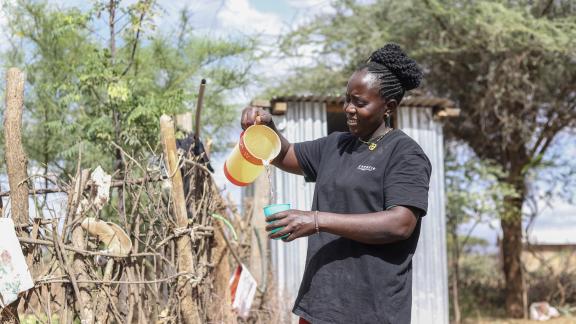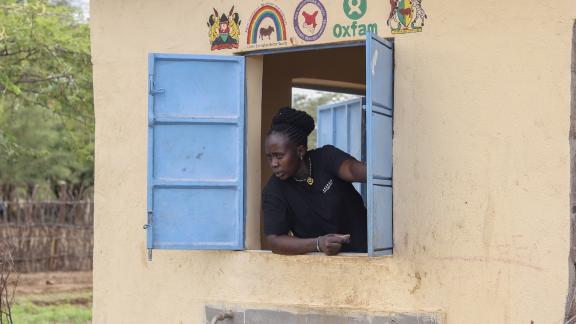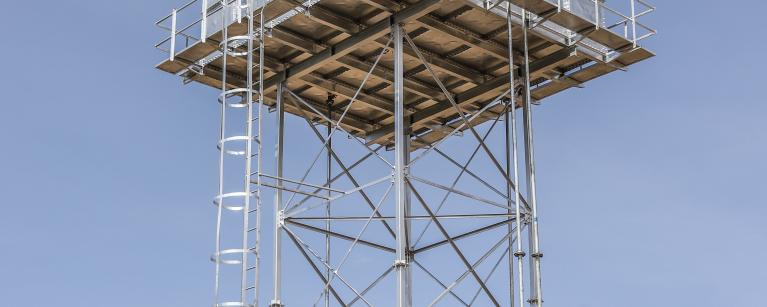We arrive at the Ngaremara Village in the Northern County of Isiolo to meet Catherine Bahati, one of the German Federal Office’s (GFFO) funded projects in the area. She leads us to her homestead just a few meters from the main water infrastructure project launched on the day of our visit. The infrastructure involves a 50 cubic meter elevated steel tank, a solarised water pump and water vending stations for communities. At the beginning of our conversation, Catherine points towards the south as if pointing towards a distant land; reminiscing about a time when the land she stands on now, was even better than the distant land. Green pasture, trees, many trees, food, and most of all water.
The drought story in Isiolo dates back a few years. A story is told of a man who visited what was then Isiolo Town. It was a flourishing town with bumper harvest. The man was shocked at how well the town was doing. Specifically, how well the vegetation was doing, it is said that he took one bite of maize that a farmer had grown and really liked it; he simply could not believe that this had grown in Isiolo. His main mission was to grow trees in the region. He tried to get pastoralists to grow trees. He failed. Their nomadic nature would not allow it. Now, however, they are really trying to incorporate farming as a way of life.
Ngaremara is not very far from the main Isiolo town, approximately 20 kilometers. It is a quiet little town; cosmopolitan because you find people from different ethnic backgrounds, all coexisting peacefully. They have one thing that unites them - Lack of water. This is where we meet Catherine Bahati, a resident of Ngaramara for over 20 years.
The emergency drought response project came to the rescue for these pastoralists. Implemented by Merti Integrated Development Program (MIDPI) under Oxfam in Kenya and funded by the German Federation Foreign Office (GFFO), the project aimed at rehabilitating existing water borehole points. For the Ngaremara region, they installed water tanks and built several water dispensing points, popularly known as kiosks in the local dialect, closer to the community members.
The newly installed water tanks ensure the community has running water. The piping from the borehole to the water points gives the community members an easier time accessing water. They also formed a water committee that helps to ensure the borehole and water tanks are running and acts as a focal point for the community. The committee regulates the timing and manages the watering points so as to ensure sustainability and good water governance for the long haul.

Catherine Bahati, a project participant in Ngaremara, Isiolo County, Kenya, at her garden.
“We used to experience bumper harvest. Then our people started cutting down trees and soon enough nature worked against us. The area dried up and we could not access any water. We have accepted this as our fate.”
“In this region having livestock is everything. We depend entirely on keeping and rearing livestock since we do not have an alternative source of livelihood. When we lose our livestock due to lack of water, we are left stranded.”

Catherine Bahati milking her goat at her homestead in Ngaremara Village.
“I was born in this county; I have experienced water scarcity for years. We have had to walk for long distances to fetch water for many years. Our parents did it, their parents did it and now we are also experiencing the same fate. We don’t want our children to go through the same thing.”

Catherine Bahati filling a cup with drinking water at her homestead in Ngaremara, Isiolo, during our interview visit.
“We used to have one borehole serving the whole Ngaremara region. The supply was so low that we were forced to fetch water at least once a week. This would last us close to 2-3 days at most and the rest of the time we had to walk extremely long distances to fetch water.”
“I am the treasurer of the water committee. My main job is to collect money from the community members. We charge KES 20 per jerry can. This money will go into helping us manage and maintain the watering point and the borehole. As a member of the committee, the burden to ensure this works is huge for me, I owe it to my community to ensure they have running water at any given time.”

Catherine Bahati at the community water vending station in Isiolo
“We used to have one borehole serving the whole Ngaremara region. The supply was so low that we were forced to fetch water at least once a week. This would last us close to 2-3 days at most and the rest of the time we had to walk extremely long distances to fetch water”
